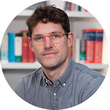Back to 2003
President Bush, Bad Santa, Sir Alex…and a rather special genome project

06 December 2018
Fifteen years – it is the equivalent of a blink of the eye in historical terms, and yet in so many ways it feels like a lifetime.
George W Bush and Tony Blair were leaders of the Free World, Love Actually and Bad Santa were playing in cinemas, and Manchester United and Arsenal were duking it out at the top of the Premier League.
In April of that year, a scientific breakthrough hit the headlines. After years of research carried out by thousands of scientists across the world, it was announced that the complete genetic code of a human being – our genome – could now be published.
Described as the largest international collaboration ever undertaken in biology, The Human Genome Project saw British scientists leading the race to, as they put it, ‘read’ the human genome, DNA letter by letter, using a technique called sequencing.
These scientists were following in the footsteps of Crick and Watson, Nobel Prize winners for their discovery of the double helix structure of DNA, and British double Nobel Prize winning scientist, Fred Sanger, who established how to sequence it.
The significance of the announcement in 2003 was palpable, presenting an opportunity to turn discoveries about DNA and the way it works into life-saving reality for NHS patients.
In late 2012, the UK launched the second phase in the process, with the establishment of the 100,000 Genomes Project.
This flagship project, delivered by Genomics England, a company owned and funded by the Department of Health & Social Care, was set up to sequence 100,000 whole genomes from NHS patients. Its ambitious aims included bringing benefit to patients and setting up a genomic medicine service for the NHS; enabling new scientific discoveries and medical insights; and kickstarting the development of a UK genomics industry.
This week the 100,000 Genomes Project has ended this "diagnostic odyssey," delivering effective treatments in some cases along the way.
The genome sequencing project has been carried out at the Wellcome Sanger Institute, near Cambridge. BBC medical correspondent, and past presenter of the AOP Awards, Fergus Walsh, explained: “There are now ambitious plans to sequence one million genomes in the UK in the next five years, as genetic testing becomes more embedded in NHS care.”
Speaking at 100% Optical 2018, Moorfields Eye Hospital consultant ophthalmologist, Mariya Moosajee, emphasised the importance of patients with inherited retinal disease getting a genetic diagnosis.
“Patients need their genetic diagnosis because we are now potentially able to offer them treatments. We can give hope to patients where previously there was none,” she explained.
“These are exciting times,” Ms Moosajee added – quite right too.
Lookout for Ms Moosajee’s CET article in OT’s February edition, where the expert offers a guide to the basics of genetic eye disease and how we are moving to the era of genomic medicine in ophthalmology.
To register and book seminar sessions for 100% Optical 2019, 12–14 January, visit its website. To attend the AOP Awards 2019 gala dinner, visit the AOP website.


Comments (0)
You must be logged in to join the discussion. Log in